Literature is an important component in science, technology, engineering, and math (STEM) programs that meet the Next Generation Science Standards and the Common Core State Standards. We have selected nonfiction and fiction titles that are good choices for introducing lessons and opening discussions on STEM topics. Some of the books suggest hands-on activities, and all are good for independent reading in the STEM disciplines.
Ages 4–8
Every Breath We Take: A Book About Air. Maya Ajmera & Dominique Browning. 2016. Charlesbridge.
 With beautiful color photographs and simple, clear text, Every Breath We Take considers the need of plants and animals for air, the properties of air, and air pollution. The book emphasizes the right of people around the world to breathe clean air—“Every breath we take should be full of clean air. Clean air is like love. It’s invisible, but it makes life better”—and offers a gentle reminder that keeping air pollution-free is everyone’s responsibility. Appended information, including a “What Can I Do to Help Keep the Air Clean” entry, will be of interest to adults wanting to continue the discussion of topics introduced in the book.
With beautiful color photographs and simple, clear text, Every Breath We Take considers the need of plants and animals for air, the properties of air, and air pollution. The book emphasizes the right of people around the world to breathe clean air—“Every breath we take should be full of clean air. Clean air is like love. It’s invisible, but it makes life better”—and offers a gentle reminder that keeping air pollution-free is everyone’s responsibility. Appended information, including a “What Can I Do to Help Keep the Air Clean” entry, will be of interest to adults wanting to continue the discussion of topics introduced in the book.
—JS
Follow the Moon Home: A Tale of One Idea, Twenty Kids, and a Hundred Sea Turtles. Philippe Cousteau & Deborah Hopkinson. Ill. Meilo So. 2016. Chronicle.
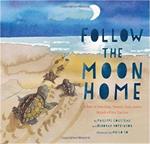 Viv, a newcomer to a South Carolina coastal town, and her classmates take on a summer school project, “Lights Out for Loggerheads,” that brings the whole community together to save newly-hatched turtles. When turtles hatch they are attracted to the bright lights of houses along the beach. Turning away from the sea, they get dehydrated and die. The children’s campaign to get the townspeople to turn outside lights off and darken windows is successful, and baby turtles follow the light of the moon to their home in the ocean. Back matter includes a letter to young activists from Philippe Cousteau outlining five steps for a community action project, a note to parents and teachers, and a two-page section on finding out more about loggerheads and other sea turtles.
Viv, a newcomer to a South Carolina coastal town, and her classmates take on a summer school project, “Lights Out for Loggerheads,” that brings the whole community together to save newly-hatched turtles. When turtles hatch they are attracted to the bright lights of houses along the beach. Turning away from the sea, they get dehydrated and die. The children’s campaign to get the townspeople to turn outside lights off and darken windows is successful, and baby turtles follow the light of the moon to their home in the ocean. Back matter includes a letter to young activists from Philippe Cousteau outlining five steps for a community action project, a note to parents and teachers, and a two-page section on finding out more about loggerheads and other sea turtles.
—CA
My Book of Birds. Geraldo Valério. 2016. Groundwood/House of Anansi.
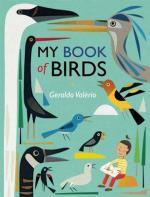 In the introduction to his “album of artistic impressions of North American birds,” Brazilian-born illustrator Geraldo Valério tells of his childhood interest in the variety of birds and their sense of freedom and his discovery of many more birds when he moved to Canada. Valério’s stylized cut-paper collage portraits, created with old magazine paper, art paper, and gift wrap, emphasize the shape, coloring, and distinctive appearance of each bird. Beautifully composed pages present the birds in their natural habitats, identified by common and scientific names, and notes on their characteristics and behavior. The front endpaper features eggs and the back endpaper feathers, created with color pencil and gouache. Back matter includes a glossary, sources of information (books Valério used in his research, websites, and books of interest to young readers), and an index.
In the introduction to his “album of artistic impressions of North American birds,” Brazilian-born illustrator Geraldo Valério tells of his childhood interest in the variety of birds and their sense of freedom and his discovery of many more birds when he moved to Canada. Valério’s stylized cut-paper collage portraits, created with old magazine paper, art paper, and gift wrap, emphasize the shape, coloring, and distinctive appearance of each bird. Beautifully composed pages present the birds in their natural habitats, identified by common and scientific names, and notes on their characteristics and behavior. The front endpaper features eggs and the back endpaper feathers, created with color pencil and gouache. Back matter includes a glossary, sources of information (books Valério used in his research, websites, and books of interest to young readers), and an index.
—CA
Outdoor Math: Fun Activities for Every Season. Emma AdBåge. 2016. Kids Can.
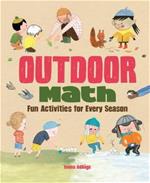 Outdoor Math takes early math outdoors with 36 activities designed to build skill in counting, measuring, sorting, patterning, time, geometry, and basic arithmetic operations. For instance, children can use objects found outdoor to sort for similarities and differences or to create simple addition or subtraction sentences. Easily adaptable to a variety of ages, the activities make hands-on math something that children can do, with guidance from teachers or parents, just by heading outside throughout the year.
Outdoor Math takes early math outdoors with 36 activities designed to build skill in counting, measuring, sorting, patterning, time, geometry, and basic arithmetic operations. For instance, children can use objects found outdoor to sort for similarities and differences or to create simple addition or subtraction sentences. Easily adaptable to a variety of ages, the activities make hands-on math something that children can do, with guidance from teachers or parents, just by heading outside throughout the year.
—JS
Platypus. Sue Whiting. Ill. Mark Jackson. 2016. Candlewick.
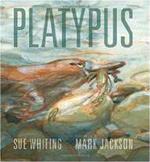 The platypus is an oddity in the animal world. It has a bill and webbed feet like a duck and fur and a tail like a beaver. It is semiaquatic and walks like a reptile on land. It lays eggs, but produces milk for its young, and it has venomous spurs behind its back legs. Platypus tells the story of a day in the life of a male platypus. He spends most of the daylight hours asleep in his burrow beneath the tangled roots of a gum tree along the bank of a creek, and he forages for worms, insect larvae, and crawfish throughout the night. The text appears against realistic mixed-media illustrations of the platypus in its natural environment. Facts related to the story appear in a smaller font. An endnote includes information on the life cycle of this monotreme, or egg-laying mammal, and threats to its survival, including predators and loss of habitat through drought, flooding, land clearing, and water pollution in its native Tasmania and eastern Australia.
The platypus is an oddity in the animal world. It has a bill and webbed feet like a duck and fur and a tail like a beaver. It is semiaquatic and walks like a reptile on land. It lays eggs, but produces milk for its young, and it has venomous spurs behind its back legs. Platypus tells the story of a day in the life of a male platypus. He spends most of the daylight hours asleep in his burrow beneath the tangled roots of a gum tree along the bank of a creek, and he forages for worms, insect larvae, and crawfish throughout the night. The text appears against realistic mixed-media illustrations of the platypus in its natural environment. Facts related to the story appear in a smaller font. An endnote includes information on the life cycle of this monotreme, or egg-laying mammal, and threats to its survival, including predators and loss of habitat through drought, flooding, land clearing, and water pollution in its native Tasmania and eastern Australia.
—CA
Peg + Cat: The Pizza Problem. Jennifer Oxley & Billy Aronson. 2016. Candlewick Entertainment/Candlewick.
 Peg and Cat, from the animated PBS series Peg + Cat, have some math problems to solve as they serve up pizza at their newly opened restaurant. What happens when someone wants a whole pizza and someone else orders a half? An engaging first introduction to fractions, this book also sneaks in some more math, including arithmetic-fact page numbers (for example, 26+1=27), as Peg and Cat handle orders and entertain customers whom children who have watched the TV program will recognize.
Peg and Cat, from the animated PBS series Peg + Cat, have some math problems to solve as they serve up pizza at their newly opened restaurant. What happens when someone wants a whole pizza and someone else orders a half? An engaging first introduction to fractions, this book also sneaks in some more math, including arithmetic-fact page numbers (for example, 26+1=27), as Peg and Cat handle orders and entertain customers whom children who have watched the TV program will recognize.
—JS
To the Stars! The First American Woman to Walk in Space. Carmella Van Vleet & Dr. Kathy Sullivan. Ill. Nicole Wong. 2016. Charlesbridge.
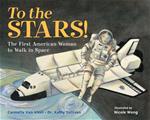 From a young age, Kathy Sullivan had a passion for adventure and never let others’ ideas of what was acceptable for girls to do stand in her way. This picture book biography alternates double-page spreads, with ink-and-watercolor illustrations, that focus on Kathy as a young girl and Dr. Kathleen Sullivan as an adult about to be launched into outer space as a member of the 1984 NASA Space Shuttlecrew. During this mission, she earned the distinction of being the first woman to take part in an extravehicular activity (EVA), also known as a “spacewalk.” Dr. Sullivan was an active participant in the writing of the book, and lead author Van Vleet does an outstanding job weaving the two time frames together. Back matter includes a personal note from Dr. Sullivan and a two-page spread featuring 13 other American women in the space program.
From a young age, Kathy Sullivan had a passion for adventure and never let others’ ideas of what was acceptable for girls to do stand in her way. This picture book biography alternates double-page spreads, with ink-and-watercolor illustrations, that focus on Kathy as a young girl and Dr. Kathleen Sullivan as an adult about to be launched into outer space as a member of the 1984 NASA Space Shuttlecrew. During this mission, she earned the distinction of being the first woman to take part in an extravehicular activity (EVA), also known as a “spacewalk.” Dr. Sullivan was an active participant in the writing of the book, and lead author Van Vleet does an outstanding job weaving the two time frames together. Back matter includes a personal note from Dr. Sullivan and a two-page spread featuring 13 other American women in the space program.
—JS
Ages 9–11
Everything Robotics (Everything). Jennifer Swanson (with Shah Selbe). 2016. National Geographic Kids.
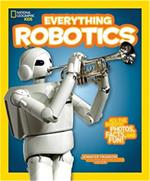 This book is chock full of text and visual information about robotics. It will take readers days and many close rereadings to digest all the information provided about the history of robotics, the influences of robotics on facets of our lives, and how to get involved with robotics challenges. The formatting of the book, with its abundance of captioned full-color photographs, diagrams, blocks of informative text, sidebars, activities and challenges is inviting. Back matter includes an interactive glossary, web links, places to visit, and an index.
This book is chock full of text and visual information about robotics. It will take readers days and many close rereadings to digest all the information provided about the history of robotics, the influences of robotics on facets of our lives, and how to get involved with robotics challenges. The formatting of the book, with its abundance of captioned full-color photographs, diagrams, blocks of informative text, sidebars, activities and challenges is inviting. Back matter includes an interactive glossary, web links, places to visit, and an index.
—JS
Living Fossils: Clues to the Past. Caroline Arnold. Ill. Andrew Plant. 2016. Charlesbridge.
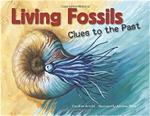 “Living fossils are a link between the prehistoric world and the present.” After introducing the concept of living fossils with the coelacanth, Arnold presents five animals—horseshoe crabs, dragonflies, sphenodontids, chambered nautiloids, and Latonia frogs—in two double-page spreads featuring realistic portraits of the animal, rendered in acrylic paint, and an accessible text about how scientists believe the animal lived then and how its descendants live now. A boxed inset lists the animal’s adaptations for survival. Back matter includes a timeline, additional information about the featured living fossils, a glossary, and a list of resources (books and websites).
“Living fossils are a link between the prehistoric world and the present.” After introducing the concept of living fossils with the coelacanth, Arnold presents five animals—horseshoe crabs, dragonflies, sphenodontids, chambered nautiloids, and Latonia frogs—in two double-page spreads featuring realistic portraits of the animal, rendered in acrylic paint, and an accessible text about how scientists believe the animal lived then and how its descendants live now. A boxed inset lists the animal’s adaptations for survival. Back matter includes a timeline, additional information about the featured living fossils, a glossary, and a list of resources (books and websites).
—CA
Science Stunts: Fun Feats of Physics. Jordan D. Brown. Ill. Anthony Owlsley. 2016. Imagine/Charlesbridge.
 Science Stunts introduces physics principles in an informative and humorous manner that will appeal to middle graders. Physicist/magician Dr. Dazzleberry (with the help of his friends Gaileo, Newton, and Einstein) explores gravity, motion, heat, magnetism, sound, light, and electricity in seven chapters. Each chapter includes a brief introduction to the topic; hands-on experiments (billed as “The Trick”), with step-by-step procedures followed by an easy-to-understand “The Science Behind the Stunt” explanation; and applications of the principle involved. Important safety tips are included and potentially dangerous experiments are labeled with an “adult sidekick needed” warning. Back matter includes brief biographies of Galileo, Newton, and Einstein; a glossary; and an index.
Science Stunts introduces physics principles in an informative and humorous manner that will appeal to middle graders. Physicist/magician Dr. Dazzleberry (with the help of his friends Gaileo, Newton, and Einstein) explores gravity, motion, heat, magnetism, sound, light, and electricity in seven chapters. Each chapter includes a brief introduction to the topic; hands-on experiments (billed as “The Trick”), with step-by-step procedures followed by an easy-to-understand “The Science Behind the Stunt” explanation; and applications of the principle involved. Important safety tips are included and potentially dangerous experiments are labeled with an “adult sidekick needed” warning. Back matter includes brief biographies of Galileo, Newton, and Einstein; a glossary; and an index.
—JS
Ages 12–14
Mission Shark Rescue: All About Sharks and How to Save Them. (Mission Animal Rescue). Ruth A. Musgrave (with Daniel Raven-Ellison). 2016. National Geographic Kids.
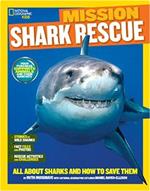 This book delivers on the promise of providing readers with a wealth of information about what is often one of students’ marine animals, sharks. Captioned full-color photographs and an engaging text cover the physical characteristics, behavior, and habitats of the different species of sharks. The focus on efforts to save and rejuvenate the populations of various sharks includes “Rescue Activities,” which are placed throughout the book and designed to get readers thinking and acting like shark conservationists to encourage kids to take action in their communities. Back matter includes an extensive resource list for students to continue their learning, a list of places to see sharks around the world, and an index.
This book delivers on the promise of providing readers with a wealth of information about what is often one of students’ marine animals, sharks. Captioned full-color photographs and an engaging text cover the physical characteristics, behavior, and habitats of the different species of sharks. The focus on efforts to save and rejuvenate the populations of various sharks includes “Rescue Activities,” which are placed throughout the book and designed to get readers thinking and acting like shark conservationists to encourage kids to take action in their communities. Back matter includes an extensive resource list for students to continue their learning, a list of places to see sharks around the world, and an index.
—JS
The Story of Seeds: From Mendel’s Garden to Your Plate, and How There’s More of Less to Eat Around the World. Nancy F. Castaldo. 2016. Houghton Mifflin Harcourt.
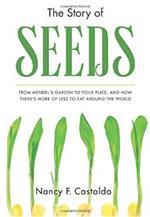 Keeping the focus on seeds being at risk, Castaldo presents an engaging introduction to the “story of seeds.” She includes a history of problems related to the lack of crop diversity such as the Irish Potato Famine in the mid-1800s and provides a global report on current threats to the world’s food supply related to habitat loss, climate change, disease, biopiracy, and agroterrorism. She covers the issue of hybridization vs. genetic modification and present-day controversy on GMO labeling, the patenting of seeds, and the growth of gigantic agribusinesses. Throughout the book Castaldo deals with seed conservation through the establishment of seed banks such as the Svalbard Global Seed Vault, seed libraries, and seed exchanges, and introduces “seed warriors,” activists from around the world working to protect seed diversity. Numerous color photographs of seeds and archival photographs add interest. Back matter includes resources, a glossary, an author’s note, sources, a timeline, and an index.
Keeping the focus on seeds being at risk, Castaldo presents an engaging introduction to the “story of seeds.” She includes a history of problems related to the lack of crop diversity such as the Irish Potato Famine in the mid-1800s and provides a global report on current threats to the world’s food supply related to habitat loss, climate change, disease, biopiracy, and agroterrorism. She covers the issue of hybridization vs. genetic modification and present-day controversy on GMO labeling, the patenting of seeds, and the growth of gigantic agribusinesses. Throughout the book Castaldo deals with seed conservation through the establishment of seed banks such as the Svalbard Global Seed Vault, seed libraries, and seed exchanges, and introduces “seed warriors,” activists from around the world working to protect seed diversity. Numerous color photographs of seeds and archival photographs add interest. Back matter includes resources, a glossary, an author’s note, sources, a timeline, and an index.
—CA
Ages 15+
Patterns in Nature: Why the Natural World Looks the Way It Does. Philip Ball. 2016. University of Chicago.
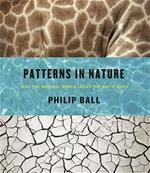 Ball offers readers a visually stunning exploration of pattern formation in the natural world. The abundance of examples (over 300 captioned photographs) accompanying his explanations of the mathematical and physical principles behind the regularity of design within the diversity of nature make this a book to be appreciated for its artistic, mathematical, and scientific contributions to understanding “why the natural world looks the way it does.” The book is organized into nine chapters: Symmetry, Fractals, Spirals, Flow and Chaos, Waves and Dunes, Bubbles and Foam, Arrays and Tiling, Cracks, and Spots and Stripes. Back matter includes a glossary, a further reading section, an index, and credits. Overall, Patterns in Nature is a volume to return to again and again to gain a better understanding of and appreciation for the beauty of the patterns found everywhere in nature.
Ball offers readers a visually stunning exploration of pattern formation in the natural world. The abundance of examples (over 300 captioned photographs) accompanying his explanations of the mathematical and physical principles behind the regularity of design within the diversity of nature make this a book to be appreciated for its artistic, mathematical, and scientific contributions to understanding “why the natural world looks the way it does.” The book is organized into nine chapters: Symmetry, Fractals, Spirals, Flow and Chaos, Waves and Dunes, Bubbles and Foam, Arrays and Tiling, Cracks, and Spots and Stripes. Back matter includes a glossary, a further reading section, an index, and credits. Overall, Patterns in Nature is a volume to return to again and again to gain a better understanding of and appreciation for the beauty of the patterns found everywhere in nature.
—CA
Jennifer W. Shettel is an associate professor at Millersville University of PA where she teaches undergraduate and graduate course in literacy for preservice and practicing teachers. Prior to joining the faculty at Millersville, she spent 16 years as an elementary classroom teacher and reading specialist in the public schools. Carolyn Angus is former director of the George G. Stone Center for Children's Books, Claremont Graduate University, in California.
These reviews are submitted by members of the International Literacy Association's Children's Literature and Reading Special Interest Group (CL/R SIG) and are published weekly on Literacy Daily.